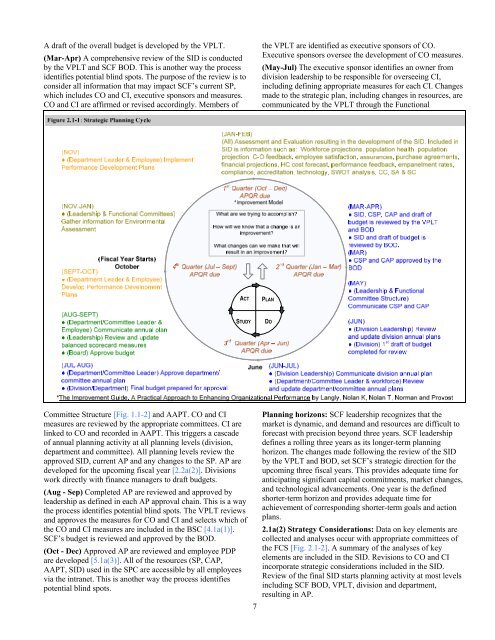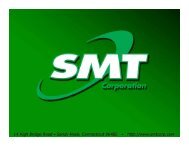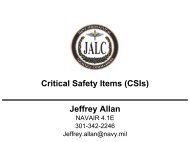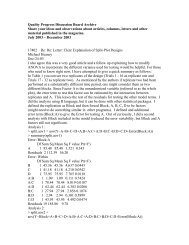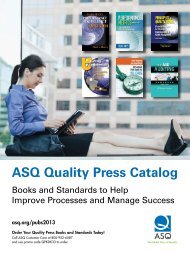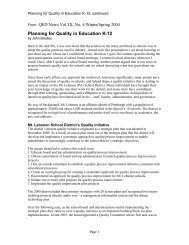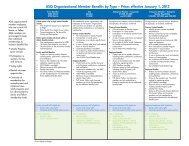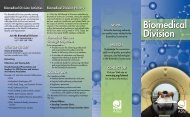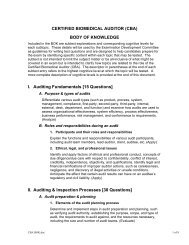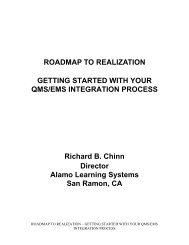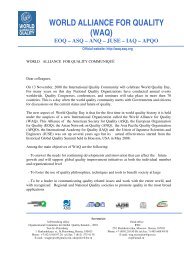Malcolm Baldrige National Quality Award - American Society for ...
Malcolm Baldrige National Quality Award - American Society for ...
Malcolm Baldrige National Quality Award - American Society for ...
Create successful ePaper yourself
Turn your PDF publications into a flip-book with our unique Google optimized e-Paper software.
A draft of the overall budget is developed by the VPLT.<br />
(Mar-Apr) A comprehensive review of the SID is conducted<br />
by the VPLT and SCF BOD. This is another way the process<br />
identifies potential blind spots. The purpose of the review is to<br />
consider all in<strong>for</strong>mation that may impact SCF’s current SP,<br />
which includes CO and CI, executive sponsors and measures.<br />
CO and CI are affirmed or revised accordingly. Members of<br />
the VPLT are identified as executive sponsors of CO.<br />
Executive sponsors oversee the development of CO measures.<br />
(May-Jul) The executive sponsor identifies an owner from<br />
division leadership to be responsible <strong>for</strong> overseeing CI,<br />
including defining appropriate measures <strong>for</strong> each CI. Changes<br />
made to the strategic plan, including changes in resources, are<br />
communicated by the VPLT through the Functional<br />
ACT<br />
PLAN<br />
STUDY<br />
DO<br />
Committee Structure [Fig. 1.1-2] and AAPT. CO and CI<br />
measures are reviewed by the appropriate committees. CI are<br />
linked to CO and recorded in AAPT. This triggers a cascade<br />
of annual planning activity at all planning levels (division,<br />
department and committee). All planning levels review the<br />
approved SID, current AP and any changes to the SP. AP are<br />
developed <strong>for</strong> the upcoming fiscal year [2.2a(2)]. Divisions<br />
work directly with finance managers to draft budgets.<br />
(Aug - Sep) Completed AP are reviewed and approved by<br />
leadership as defined in each AP approval chain. This is a way<br />
the process identifies potential blind spots. The VPLT reviews<br />
and approves the measures <strong>for</strong> CO and CI and selects which of<br />
the CO and CI measures are included in the BSC [4.1a(1)].<br />
SCF’s budget is reviewed and approved by the BOD.<br />
(Oct - Dec) Approved AP are reviewed and employee PDP<br />
are developed [5.1a(3)]. All of the resources (SP, CAP,<br />
AAPT, SID) used in the SPC are accessible by all employees<br />
via the intranet. This is another way the process identifies<br />
potential blind spots.<br />
7<br />
Planning horizons: SCF leadership recognizes that the<br />
market is dynamic, and demand and resources are difficult to<br />
<strong>for</strong>ecast with precision beyond three years. SCF leadership<br />
defines a rolling three years as its longer-term planning<br />
horizon. The changes made following the review of the SID<br />
by the VPLT and BOD, set SCF’s strategic direction <strong>for</strong> the<br />
upcoming three fiscal years. This provides adequate time <strong>for</strong><br />
anticipating significant capital commitments, market changes,<br />
and technological advancements. One year is the defined<br />
shorter-term horizon and provides adequate time <strong>for</strong><br />
achievement of corresponding shorter-term goals and action<br />
plans.<br />
2.1a(2) Strategy Considerations: Data on key elements are<br />
collected and analyses occur with appropriate committees of<br />
the FCS [Fig. 2.1-2]. A summary of the analyses of key<br />
elements are included in the SID. Revisions to CO and CI<br />
incorporate strategic considerations included in the SID.<br />
Review of the final SID starts planning activity at most levels<br />
including SCF BOD, VPLT, division and department,<br />
resulting in AP.


